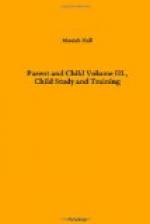“But this educability of the higher mammals and birds is, after all, quite limited. Conservatism still continues in fashion. One generation is much like another. It would be easy for foxes to learn to climb trees, and many a fox might have saved his life by so doing; yet quick-witted as he is, this obvious device has never occurred to him.”
The vital problem with parents is how to fill this period of plasticity, how to provide an educative environment of the right kind.
Luther Burbank, in “The Training of the Human Plant,” expresses complete confidence in the power of the environment through appropriate training to fashion the normal child, just as he could a plant, into a most delightful and beautiful specimen of its kind. He says: “Pick out any trait you want in your child, granted that he is a normal child, be it honesty, fairness, purity, lovableness, industry, thrift, what not. By surrounding this child with sunshine from the sky and your own heart, by giving the closest communion with nature, by feeding this child well-balanced, nutritious food, by giving it all that is implied in healthful environmental influences, and by doing all in love, you can thus cultivate in the child and fix there for all its life all of these traits, and on the other side, give him foul air to breathe, keep him in a dusty factory or an unwholesome school-room or a crowded tenement up under the hot roof; keep him away from the sunshine, take away from him music and laughter and happy faces; cram his little brains with so-called knowledge; let him have vicious associates in his hours out of school, and at the age of ten you have fixed in him the opposite traits. You have, perhaps, seen a prairie fire sweep through the tall grass across a plain. Nothing can stand before it, it must burn itself out. That is what happens when you let weeds grow up in your child’s life, and then set fire to them by wrong environment.”
Mr. Burbank is probably over-enthusiastic in his belief that natural education can do everything for the child; but it is certain that environment does exercise a powerful influence, during the plastic age, in determining his character.
LESSON IV
QUESTIONS FOR DISCUSSION
1. Compare the helplessness of the infant at birth with the ability of the young of other animals.
2. At one year of age, what is the comparison?
3. What is the significance of prolonged infancy respecting (a) possibility of adjustment to environment, (b) possibility of training and education, (c) possibility of profiting from experience, (d) the relation to heredity?
4. What advantage is it that man is born with the germs of many capacities instead of with a few activities that are perfectly developed?
5. What is the chief function of education?
6. What does Burbank say respecting the possibilities of training?




